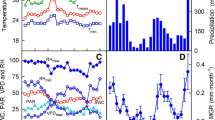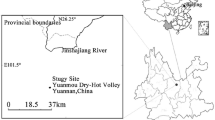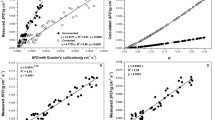Abstract
Lack of data on water use of key species of drylands constitutes an obstacle to understanding their role in hydrological processes in this environment. To elucidate seasonal variation in water consumption by Vitellaria paradoxa, the dominant species of parklands of the semi-arid areas of West Africa, we’ve measured its transpiration using heat ratio method (HRM) and seven potential explanatory variables. Sap flux was found to be significantly different among years with 0.64, 0.59 and 0.67 L h−1 dm−2 in 2008, 2009 and 2010, respectively. Sap flux was significantly higher in the dry (0.73 L h−1 dm−2) than in the wet season (0.53 L h−1 dm−2). Nighttime sap flux during dry season (0.48 L h−1 dm−2) was significantly higher than that of the wet season (0.20 L h−1 dm−2) and it contributes on average to 26% of daily sap flow with a maximum reaching 49%. The mean transpiration rate per tree was 151 L day−1 and all measured variables except rainfall and soil water content were significantly correlated with sap flux. These correlations were stronger (higher R value) during the rainy than in the dry season. Vapor Pressure Deficit (VPD) explained the highest proportion of sap flux variation and their curve was of parabolic type (R2 = 0.54) indicating that V. paradoxa can probably down-regulate its canopy conductance beyond a certain threshold of VPD, which is about 3 kPa in the present study. Future studies should investigate such hypothesis as well as the impacts of the variation of V. paradoxa transpiration due to climatic variables on hydrological cycles.






Similar content being viewed by others
References
Aleza K, Wala K, Bayala J, Villamor GB, Dourma M, Atakpama W, Akpagana K (2015) Population structure and regeneration status of Vitellaria Paradoxa (C. F. Gaertner) under different land management regimes in Atacora department, Benin. Agrofor Syst 89(3):511–523
Allen RG, Pereira LS, Raes D, Smith M (1998) Crop evapotranspiration: guidelines for computing crop requirements. Irrigation and Drainage Paper No. 56, FAO, Rome
Allen RG, Pruitt WO, Wright JL, Howell TA, Ventura F, Snyder R (2006) A recommendation on standardized surface resistance for hourly calculation of reference ET0 by the FAO-56 Penman–Monteith method. Agric Water Manage 81:1–22
Alvarado-Barrientos MS, Holwerda F, Geissert DR, Muňoz-Villers LE, Gotsch SG, Asbjornsen H, Dawson TE (2015) Nighttime transpiration in a seasonally dry tropical montane cloud forest environment. Trees 29:259–274
Asbjornsen H, Tomer MD, Gomez-Cardenas M, Brudvig LA, Greenan CM, Schilling K (2007) Tree and stand transpiration in a Midwestern bur oak savanna after elm encroachment and restoration thinning. For Ecol Manage 247:209–219
Awessou KGB, Peugeot C, Rocheteau A, Seguis L, Do FC, Galle S, Bellanger M, Agbossou E, Seghieri J (2017) Differences in transpiration between a forest and an agroforestry tree species in the Sudanian belt. Agrofor Syst 91(3):403–413. doi:10.1007/s10457-016-9937-8
Bargués Tobella A, Hasselquist NJ, Bazié HR, Nyberg G, Laudon H, Bayala J, Ilstedt U (2016) Strategies trees use to overcome seasonal water limitation in an agroforestry system in semiarid West Africa. Ecophydrology. doi:10.1002/eco.1808
Barrett DJ, Hatton TJ, Ash JE, Ball MC (1995) Evaluation of the heat pulse velocity technique for measurement of sap flow in rainforest and eucalypt forest species of south-eastern Australia. Plant Cell Environ 18:463–469
Bates BC, Kundzewicz ZW, Wu S, Palutikof JP (2008) Climate change and water. Technical paper of the intergovernmental panel on climate change. IPCC Secretariat, Geneva
Bayala J (2002) Trees crown pruning as management tool to enhance the productivity of parkland in West Africa. Ph.D. Dissertation, School of Agricultural and Forest Sciences, University of Wales, Bangor
Bayala J, Teklehaimanot Z, Ouedraogo SJ (2002) Millet production under crown pruned trees in a parkland system in Burkina Faso. Agrofor Syst 54:203–214
Bayala J, Heng LK, van Noordwijk M, Ouedraogo SJ (2008a) Hydraulic redistribution study in two native tree species of agroforestry parklands of West African dry savanna. Acta Oecol 34:370–378
Bayala J, Ouedraogo SJ, Teklehaimanot Z (2008b) Rejuvenating indigenous trees in agroforestry parkland systems for better fruit production using crown pruning. Agrofor Syst 72:187–194
Bayala J, van Noordwijk M, Lusiana B, Kasanah N, Teklehaimanot Z, Ouedraogo SJ (2008c) Separating the tree–soil–crop interactions in agroforestry parkland systems in Saponé (Burkina Faso) using WaNuLCAS. Adv Agrofor 4:296–308
Bayala J, Ouédraogo SJ, Ong CK (2009) Early growth performance and water use of planted West African provenances of Vitellaria paradoxa C.F. Gaertn (karité) in Gonsé, Burkina Faso. Agrofor Syst 75:117–127
Bayala J, Kindt R, Belem M, Kalinganire A (2011) Factors affecting the dynamics of tree diversity in agroforestry parklands of cereal and cotton farming systems in Burkina Faso. New For 41:281–296
Bayala J, Sanou J, Teklehaimanot Z, Ouedraogo SJ, Kalinganire A, Coe R, van Noordwijk M (2015) Advances in knowledge of processes in soil–tree–crop interactions in parkland systems in the West African Sahel: a review. Agric Ecosyst Environ 205:25–35
Bazié HR (2013) Interactions arbres-cultures et rôles des parcs agroforestiers à Vitellaria paradoxa (C:F:Gaertn) sur les paramètres du bilan hydrique au Burkina Faso. Thèse de doctorat, Université de Ouagadougou, Ouagadougou
Bazié HR, Bayala J, Zombré G, Sanou J, Ilstedt U (2012) Separating competition-related factors limiting crop performance in an agroforestry parkland system in Burkina Faso. Agrofor Syst 84:377–388
Bleby TM, Burgess SSO, Adams MA (2004) A validation, comparison and error analysis of two heat-pulse methods for measuring sap flow in Eucalyptus marginata seedlings. Funct Plant Biol 31:645–658
Boffa JM (1995) Productivity and management of agroforestry parklands in the Sudan Zone of Burkina Faso, West Africa. Ph.D. thesis, Purdue University, West Lafyette
Boffa JM (1999) Agroforestry parklands in sub-Saharan Africa. FAO Conservation Guide 34. Rome
Boffa JM (2000) Les parcs agroforestiers en Afrique de l’Ouest: clés de la conservation et d’une gestion durable. Unasylva 51:11–17
Bonkoungou EA (1987) Monographie du karité Butyrospermun paradoxum (gaertn. F.) Hepper, espèce agroforestière à usages multiples. Institut de Recherches en Biologie et Ecologie Tropicale, Ouagadougou
Burgess SSO (2006) Measuring transpiration responses to summer precipitation in a Mediterranean climate: a simple screening tool for identifying plant water-use strategies. Physiol Plant 127:404–412
Burgess SSO, Dawson TE (2004) The contribution of fog to the water relations of Sequoia sempervirens (D. Don): foliar uptake and prevention of dehydration. Plant Cell Environ 27:1023–1034
Burgess SSO, Adams MA, Turner NC, Beverly CR, Ong CK, Khan AAH, Bleby TM (2001) An improved heat pulse method to measure low and reverse rates of sap flow in woody plants. Tree Physiol 21:589–598
Bužková R, Acosta M, Dařenová E, Pokorný R, Pavelka M (2014) Environmental factors influencing the relationship between stem CO2 efflux and sap flow. Trees 29:333–343
Chapin FS, Matson PA, Mooney HA, Chapin MC (2002) Principles of terrestrial ecosystem ecology. Springer, New York
Chelcy RF, Carol EG, Robert JM, Rodney EW, Robert OT (2005) Modeling canopy transpiration using time series analysis: a case study illustrating the effect of soil moisture deficit on Pinus taeda. Agric For Meteorol 130:163–175
Cienciala E, Kučera J, Malmer A (2000) Tree sap flow and stand transpiration of two Acacia mangium plantations in Sabah, Borneo. J Hydrol 236:109–120
Dawson TE, Burgess SSO, Tu KP, Oliveira RS, Santiago LS, Fisher JB, Simonin KA, Ambrose AR (2007) Nighttime transpiration in woody plants from contrasting ecosystems. Tree Physiol 27:561–575
Doronila AI, Forster MA (2015) Performance measurement via sap flow monitoring of three Eucalyptus species for mine site and dryland salinity phytoremediation. Int J Phytorem 17(1–6):101–108
Elias M, Carney J (2007) African shea butter: a feminized subsidy from nature. Africa 77:37–62
Ewers BE, Mackay DS, Gower ST, Ahl DE, Burrows SN, Samanta SS (2002) Tree species effects on stand transpiration in northern Wisconsin. Water Resour Res 38:1–11
Feddes RA, Hoff H, Bruen M, Dawson T, de Rosnay P, Dirmeyer O, Jackson RB, Kabat P, Kleidon A, Lilly A, Pitman AJ (2001) Modeling root water uptake in hydrological and climate models. B Am Meteorol Soc 82:2797–2809
Food and Agriculture Organization of the United Nations (FAO) (1998) World Soil resources reports. International Society of Soil Science ISSS-AISS-IBG, Rome
Forster MA (2014) How significant is nocturnal sap flow. Tree Physiol 34:757–765
Giambelluca TW, Ziegler AD, Nullet MA, Truong DM, Tran LT (2003) Transpiration in a small tropical forest patch. Agric For Meteorol 117:1–22
Granier A, Bréda N (1996) Modelling canopy conductance and stand transpiration of an oak forest from sap flow measurements. Ann For Sci 53:537–546
Hall JB, Aebischer DP, Tomlinson HF, Osei-Amaning E, Hindle JR (1996) Vitellaria paradoxa, a monograph. School of Agricultural and Forest Sciences, University of Bangor, Bangor
Hopper SD, Gioia P (2004) The Southwest Australian floristic region: evolution and conservation of a global hot spot of biodiversity. Annu Rev Ecol Evol S 35:623–650
Horton JL, Hart SC (1998) Hydraulic lift—a potentially important ecosystem process. Trends Ecol Evol 13:232–235
Huntington TG (2006) Evidence for intensification of the global water cycle: review and synthesis. J Hydrol 319:83–95
Ilstedt U, Malmer A, Verbeeten E, Murdiyarso D (2007) The effect of afforestation on water infiltration in the tropics: a systematic review and meta-analysis. For Ecol Manage 251:45–51
Jones H (1998) Stomatal control of photosynthesis and transpiration. J Exp Bot 49:387–398
Jonsson K, Ong CK, Odongos JCW (1999) Influence of scattered néré and karité on microclimate, soil fertility and millet yield in Burkina Faso. Exp Agric 35:39–53
Kelly BA, Bouvet MJ, Picard N (2004) Size class distribution and spatial pattern of Vitellaria paradoxa in relation to farmers’ practices in Mali. Agrofor Syst 60:3–11
Kelly BA, Fleury SG, Bouvet MJ (2007) Impact of agroforestry practices on the flowering phenology of Vitellaria paradoxa in parklands in southern Mali. Agrofor Syst 71:67–75
Lamien N, Sidibe A, Bayala J (1996) Use and commercialization of non-timber forest products in Western Burkina Faso. In: Leakey RRB, Temu AB, Melnuk M, Vantomme P (eds) Domestication and commercialization of non-timber forest products in agroforestry systems. Non-Wood Forest Products No 9. FAO, Rome, Italy, pp 51–64
Lamien N, Tigabu M, Oden PC, Guinko S (2006) Effets de l’incision annulaire sur la reproduction du karité (Vitellaria paradoxa C.F. Gaertn.) à Bondoukuy, Burkina Faso. Fruits 61:303–312
Li X-y, Yang Z-p, Li Y-t, Lin H (2009) Connecting ecohydrology and hydropedology in desert shrubs: stemflow as a source of preferential flow in soils. Hydrol Earth Syst Sci 13:1133–1144
Lovett PN, Haq N (2000) Diversity of the Sheanut tree (Vitellaria paradoxa C.F. Gaertn.) in Ghana. Genet Resour Crop Evol 47:293–304
Marshall DC (1958) Measurement of sap flow in conifers by heat transport. Plant Physiol 33:385–396
Myers N, Mittermeier RA, Mittermeier CG, Da Fonseca GAB, Kent J (2000) Biodiversity hotspots for conservation priorities. Nature 403:853–858
Oguntunde GP (2007) Water use pattern and canopy processes of cashew trees during a drying period in West Africa. Int J Plant Prod 1:85–98
Okullo JBL, Obua J, Okello G (2004) Use of indigenous knowledge in predicting fruit production of shea butter tree in agroforestry parklands of north-eastern Uganda, Uganda. J Agric Sci 9:360–366
Pallo PF (2001) Soil fertility studies. In: Douglas JD, Munro RC (eds) The second annual report of the project minimising competition in dryland agroforestry. INCODC ERBIC18CT98 0322. Centre for Ecology and Hydrology, Edinburgh, pp 8–17
Pataki DE, Oren R (2003) Species differences in stomatal control of water loss at the canopy scale in a mature bottomland deciduous forest. Adv Water Resour 26:1267–1278
Pfautsch S, Bleby TM, Rennenberg H, Adams MA (2010) Sap flow measurements reveal influence of temperature and stand structure on water use of Eucalyptus regnans forests. For Ecol Manage 259:1190–1199
Pfautsch S, Keitel C, Turnbull T, Braimbridge MJ, Wright TE, Simpson RR, O’Brien JA, Adams MA (2011) Diurnal patterns of water use in Eucalyptus victrix indicate pronounced desiccation–rehydration cycles despite unlimited water supply. Tree Physiol 31:1041–1051
Phillips NG, Lewis JD, Logan BA, Tissue DT (2010) Inter- and intra-specific variation in nocturnal water transport in Eucalyptus. Tree Physiol 30:586–596
Pouliot M (2012) Contribution of “women’s gold” to West African livelihoods: the case of Shea (Vitellaria paradoxa) in Burkina Faso. Econ Bot 66(3):237–248
Sperry JS, Alder NN, Eastlack SE (1993) The effect of reduced hydraulic conductance on stomatal conductance and xylem cavitation. J Exp Bot 44:1075–1082
Teklehaimanot Z (2004) Exploiting the potential of indigenous agroforestry trees: Parkia biglobosa and Vitellaria paradoxa in sub-Saharan Africa. Agrofor Syst 61:207–220
Ting KC, Giacomelli GA (1987) Availability of solar photosynthetically active radiation. Trans ASAE 30:1453–1457
Van Kanten R, Vaast P (2006) Transpiration of arabica coffee and associated shade tree species in sub-optimal. Low-altitude conditions of Costa Rica. Agrofor Syst 67:187–202
Vertessy RA, Benyon RG, O’Sullivan SK, Gribben PR (1995) Relationships between stem diameter, sapwood area, leaf area and transpiration in a young mountain ash forest. Tree Physiol 15:559–567
Wang H, Zhao P, Hölscher D, Wang Q, Lu P, Cai XA, Zeng XP (2012) Nighttime sap flow of Acacia mangium and its implications for nighttime transpiration and stem water storage. J Plant Ecol 5(3):294–304
Wright IJ, Westoby M (2002) Leaves at low versus high rainfall: coordination of structure, lifespan and physiology. New Phytol 155:403–416
Zomboudre G, Zombre G, Ouedraogo M, Guinko S, Macauley HR (2005) Réponse physiologique et productivité des cultures dans un système agroforestier traditionnel: cas du maïs (Zea mays L.) associé au karité (Vitellaria paradoxa Gaerth.) dans la zone Est du Burkina Faso. BASE 9(1):75–85
Acknowledgements
This study was conducted as part of the project “Trees, carbon and water: Trade-off or synergy in local adaptation to climate change in the semi-arid Tropics? SWE-2009-176” funded by the Swedish International Development Cooperation Agency-Department for Research Cooperation, SAREC. We acknowledge the financial support of FTA CRP of the CGIAR (or CRP6). We thank the farmers in Saponé for permission to conduct the study on their land. We also thank Siaka Yaméogo and Achille Belem for their assistance during the data collection.
Author information
Authors and Affiliations
Corresponding author
Ethics declarations
Conflict of interest
The authors declare that they have no conflict of interest.
Rights and permissions
About this article
Cite this article
Bazié, H.R., Sanou, J., Bayala, J. et al. Temporal variations in transpiration of Vitellaria paradoxa in West African agroforestry parklands. Agroforest Syst 92, 1673–1686 (2018). https://doi.org/10.1007/s10457-017-0115-4
Received:
Accepted:
Published:
Issue Date:
DOI: https://doi.org/10.1007/s10457-017-0115-4




